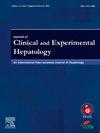Prevalence and Clinical Correlation of Cardiometabolic Risk Factors in Alcohol-Related Liver Disease and Metabolic Dysfunction and Alcohol Associated Liver Disease (MetALD)
IF 3.3
Q2 GASTROENTEROLOGY & HEPATOLOGY
Journal of Clinical and Experimental Hepatology
Pub Date : 2024-12-19
DOI:10.1016/j.jceh.2024.102492
引用次数: 0
Abstract
Background
Recent introduction of new steatotic liver disease categorizations has necessitated updated epidemiologic studies. Specifically, recognition of (1) “MetALD” defined as where metabolic dysfunction–associated steatotic liver disease (MASLD) overlaps with alcohol use and (2) alcohol-related liver disease (ALD) without cardiometabolic risk factors (CMRFs) creates new clinical phenotypes with undefined prevalence.
Methods
We conducted a cross-sectional multicenter analysis of liver disease associated with alcohol use (ALD and MetALD). We included adults with an International Classification of Diseases (ICD) diagnosis of ALD or both metabolic dysfunction associated liver disease and alcohol use disorder assigned from 1/1/2000–1/1/2024.
Results
Among 4057 patients, only 118 (2.9%) did not have any CMRF (“pure ALD”). Compared to patients with CMRF, patients with pure ALD were more commonly female (56% [0 CRMF] vs. 48%, 45%, 38%, and 42% [1, 2, 3, and 4 CMRFs, respectively]; P < 0.01) and younger (54 vs. 53, 60, 68, and 67 years [1, 2, 3, and 4 CMRFs, respectively]; P < 0.01). Those with pure ALD had higher rates of cirrhosis (49% vs. 39%, 31%, 30%, 34% [1, 2, 3, and 4 CMRFs, respectively]; P < 0.01), hepatocellular carcinoma (10% vs. 6.9%, 5.7%, 4.3%, and 5.1% [1, 2, 3, and 4 CMRFs, respectively]), and death (21% vs. 15%, 17%, 18%, and 21% [1, 2, 3, and 4 CMRFs, respectively]; P = 0.04). Patients whose only CMRF was body mass index (BMI) 25–30 kg/m2 did not differ significantly from patients with pure ALD. Factors associated with cirrhosis in univariable analysis included male sex (odds ratio [OR]: 1.47, confidence interval [CI]: 1.29–1.67), age (OR: 1.08 per 10 years, CI: 1.03–1.13), and diabetes (OR: 1.21, CI: 1.05–1.40) but not BMI 25–30 kg/m2 (OR: 0.86, CI: 0.64–1.14). No differences in single-nucleotide polymorphisms (PNPLA3, GCKR, TM6SF2, MBOAT7, or HSD17B12) were identified between groups.
Conclusions
ALD without diagnosed metabolic disease is uncommon and associated with higher rates of cirrhosis, HCC, and all-cause mortality than ALD with concurrent CMRF. Having a BMI measuring 25–30 kg/m2 did not impact these clinical outcomes, raising the question of optimal BMI cut-off for MetALD. Further investigating these novel disease categories is essential for better understanding their biology and clinical impact.
求助全文
约1分钟内获得全文
求助全文
来源期刊

Journal of Clinical and Experimental Hepatology
GASTROENTEROLOGY & HEPATOLOGY-
CiteScore
4.90
自引率
16.70%
发文量
537
审稿时长
64 days
 求助内容:
求助内容: 应助结果提醒方式:
应助结果提醒方式:


